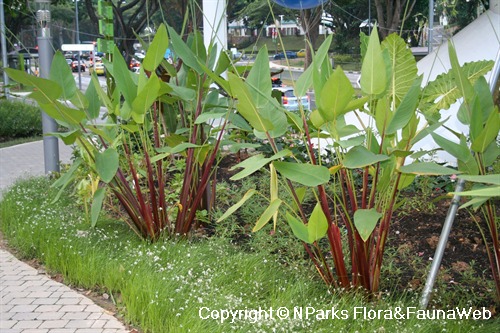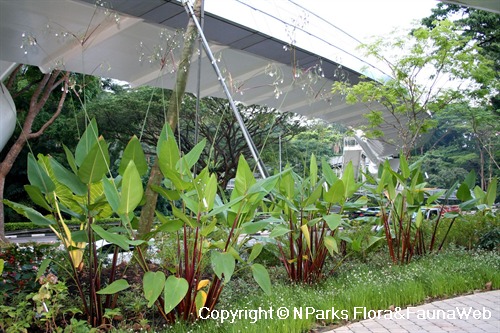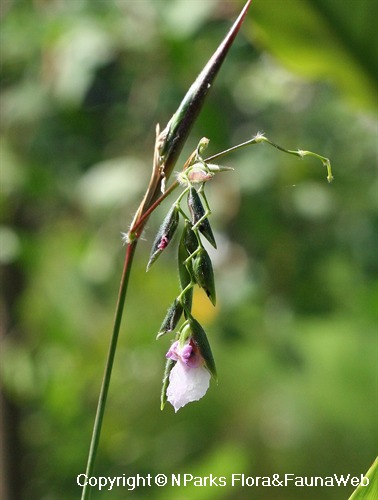
Back
Thalia geniculata (red-stemmed)
| Family Name: | Marantaceae |
| Synonyms: | Thalia geniculata f. rheumoides |
| Common Name: | Red Thalia, Red-stemmed Alligator Flag |
Name
Classifications and Characteristics
| Plant Division | Angiosperms (Flowering Seed Plants) (Monocotyledon) |
|---|---|
| Plant Growth Form | Aquatic & Hydrophyte (Emergent Aquatic), Herbaceous Plant |
| Lifespan (in Singapore) | Perennial |
| Mode of Nutrition | Autotrophic |
| Plant Shape | Shrubby |
| Maximum Height | 2.4 m to 3 m |
| Maximum Plant Spread / Crown Width | 0.6 m to 0.9 m |
Biogeography
| Native Distribution | Florida, Central America (West Indies) |
|---|---|
| Native Habitat | Terrestrial (Riverine) |
| Preferred Climate Zone | Tropical |
Description and Ethnobotany
| Others - Plant Morphology | Marginal or emergent aquatic shrub, herbaceous, up to 3m height. Ideal for boggy waterlogged areas, pond edges and shallow water (15cm depth).Leaves lime-green, architectural. Flowers lavender and white, held in clusters of zigzag stalks high above foliage, stalks become more pendulous with successive blooms. Stems intense solid red or striped with red, ornamental. Propagate by division or seeds. Its common name, Alligator Flag, may be due to plant's native habitat at deeper waters of cypress swamps, where alligators are likely to be found. |
|---|---|
| Taxonomy | In the horticultural trade, this plant is sometimes referred to as Thalia geniculata f. ruminoides. |
Landscaping Features
| Desirable Plant Features | Ornamental Flowers, Ornamental Stems |
|---|---|
| Landscape Uses | Riverine, Flowerbed / Border, Swimming Poolside, Focal Plant, Container Planting |
| Thematic Landscaping | Water Garden, Naturalistic Garden |
Fauna, Pollination and Dispersal
| Pollination Method(s) | Biotic (Fauna) (Insects (Bee), Associated with: Carpenter bees (Xylocopa spp. ) are reported to pollinate T. geniculata in Costa Rica.) |
|---|---|
| Seed or Spore Dispersal | Abiotic (Water), Biotic (Fauna) |
Plant Care and Propagation
| Light Preference | Full Sun, Semi-Shade |
|---|---|
| Water Preference | Lots of Water |
| Plant Growth Rate | Fast to Moderate |
| Rootzone Tolerance | Easy to Grow, Waterlogged Soils (Drains Site) |
| Maintenance Requirements | Moderate |
| Propagation Method | Seed, Division |
Foliar
| Foliage Retention | Evergreen |
|---|---|
| Mature Foliage Colour(s) | Green |
| Mature Foliage Texture(s) | Smooth |
| Foliar Type | Simple / Unifoliate |
| Foliar Arrangement Along Stem | Basal |
| Foliar Shape(s) | Non-Palm Foliage (Ovate) |
| Foliar Venation | Parallel |
| Foliar Margin | Entire |
| Foliar Apex - Tip | Acuminate |
| Foliar Base | Rounded / Obtuse |
| Typical Foliar Area | Notophyll ( 20.25cm2 - 45 cm2 ) |
Non - Foliar and Storage
| Stem Type & Modification | Herbaceous |
|---|---|
| Root Type | Underground (Fibrous Root) |
| Specialised Storage Organ(s) | Underground (Rhizome) |
Floral (Angiosperm)
| Flower & Plant Sexuality | Bisexual Flowers |
| Flower Colour(s) | Purple, White |
|---|---|
| Flowering Period | Free-Flowering |
| Flowering Opening Time | Time-Independent |
| Flower Lifespan on Plant | Several Days |
| Flowering Habit | Polycarpic |
Image Repository
Others
| Master ID | 21764 |
|---|---|
| Species ID | 3373 |
| Flora Disclaimer | The information in this website has been compiled from reliable sources, such as reference works on medicinal plants. It is not a substitute for medical advice or treatment and NParks does not purport to provide any medical advice. Readers should always consult his/her physician before using or consuming a plant for medicinal purposes. |










